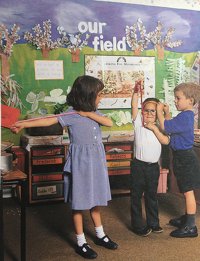a) you need to know where to find rich maths problems, challenges and investigations
b) you need to be able to adapt or apply a context to a problem to match your own theme.
The first is solved by knowing where to look, but the second is a little harder as it takes practise and a deeper understanding of teaching and learning mathematics. However, it is a skill I’ve seen teachers develop over time.
Finding problem-solving activities and investigations
This is an ongoing process of collecting ideas. I’ve got a folder of magazine cuttings and handwritten activities which I started in my first few years of teaching as well as folders of ideas on my computer. I add new ideas all the time as I find them on-line or in books - maths activities never go out of date!
Get organisedThink about how you will collate and organise these resources so that you can access them easily in the future. You may wish to follow the system I have for my Broadbent Maths users, with activities under the main headings such as Addition and Subtraction, Geometry, Multiplication and Division, Fractions, Measures, Number and Place value. At the early planning stage of a unit of work, have these accessible and easy to scroll through as they can often help spark an idea and lead the maths down a creative pathway.
Where to look?
There are many online resources, but it is often hard to know whether the activities will work in the classroom and if they are mathematically sound. I would recommend NRICH, it is free and full of great starting points for problems. It wasn't always easy to find a suitable problem to match a specific maths focus, but the search facility is much improved. The best approach is to set aside some time to look through each topic and collect a variety of activities you like ready for when you are teaching that topic. For Broadbent Maths users use the Maths Topics menu or go to your Year Unit Plans and follow the links from each unit to find specific maths activities and problems.
The Association of Teachers of Mathematics (ATM) also has some excellent booklets, such as Primary Points of Departure. It is likely that there are some old maths books in a cupboard in school, especially teachers’ guides that will have some great ideas, and also make use of the old Numeracy Strategy problem-solving documents and resources, such as Challenging More Able Children.
Ready to plan
Your planning should always start with the maths focus. Read through the learning objectives, the expected outcomes and the small steps of progression to work out the appropriate pitch for your class. These headings are from my planning templates, but if you're not using them, the same information should be on your medium-term plans. Then find problems that allows children to apply their new skills and understanding. Consider prompts and questions to add challenge or support and practical resources to help children model the problems.
Setting a problem around a context
Choose your context
Your theme might come from another curriculum subject, the maths activities you have collected or it could be based on a stand-alone context. Choose a context that is relevant to the interests of your class. This won't be used for every maths lesson, but it could draw together some of the lessons, putting the maths in context to help make sense of it for your children.
Adapting the problem to your chosen context
Teachers often find this difficult. However once you have given it a try and had a bit of practise I'm sure you'll be hooked. Take a look at these examples and you will see how a simple starting point can be changed to fit a context.
KS1 example problem:
A square has a red dot in each corner and 5 blue dots on each side. How many dots are there altogether?
This is a classic starting point (and an interesting problem) – but set it into a context and the task is likely to grab the children's attention and give more purpose to it. It will certainly make it more interesting to model or act out:
Context: nature / trees / living things
A square playing field has an oak tree in each corner and 5 ash trees on each side. How many trees are there altogether?
Context: dance in PE / festivals / parties
A dance starts with everyone standing on the sides of a square. There is an adult at each corner and 5 children on each side. How many dancers are there altogether?
Context: space
A new constellation has been found. It is in the shape of a 2D square with a planet at each corner and 5 stars on each side of the square. How many stars and planets are there altogether in this constellation?



